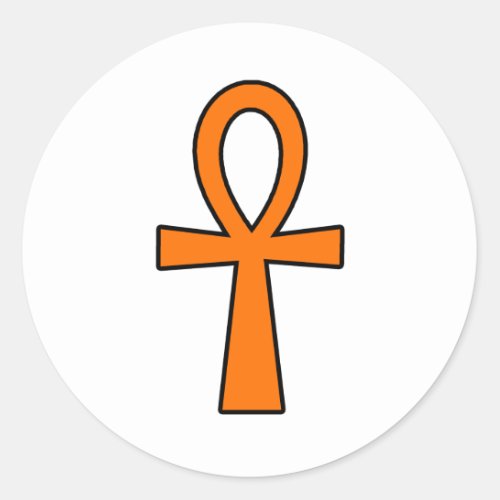Ankh Egyptian Hieroglyphic Symbols Life Key Orange Classic Round Sticker



Egyptian gods are often portrayed carrying it by its loop, or bearing one in each hand, arms crossed over their chest. The origin of the symbol remains a mystery to Egyptologists, and no single hypothesis has been widely accepted. One of the earliest suggestions is that of Thomas Inman, first published in 1869: [It] is by Egyptologists called the symbol of life It is also called the 'handled cross,' or crux ansata. It represents the male triad and the female unit, under a decent form. There are few symbols more commonly met with in Egyptian art. In some remarkable sculptures, where the sun's rays are represented as terminating in hands, the offerings which these bring are many a crux ansata, emblematic of the truth that a fruitful union is a gift from the deity. E. A. Wallis Budge postulated that the symbol originated as the belt-buckle of the mother goddess Isis[citation needed], an idea joined by Wolfhart Westendorf with the notion that both the ankh and the knot of Isis were used as ties on ceremonial girdles. Sir Alan Gardiner speculated that it represented a sandal strap, with the loop going around the ankle. The word for sandal strap was also spelled ʿnḫ, although it may have been pronounced differently. The ankh appears frequently in Egyptian tomb paintings and other art, often at the fingertips of a god or goddess in images that represent the deities of the afterlife conferring the gift of life on the dead person's mummy; this is thought to symbolize the act of conception[citation needed]. Additionally, an ankh was often carried by Egyptians as an amulet, either alone, or in connection with two other hieroglyphs that mean "strength" and "health" (see explication of Djed and Was, above). Mirrors of beaten metal were also often made in the shape of an ankh, either for decorative reasons or to symbolize a perceived view into another world[citation needed]. The ankh was almost never drawn in silver; as a sun-symbol, the Egyptians almost invariably crafted important examples of it (for tombs or other purposes) from the metal they most associated with the sun, gold. A similar metal such as copper, burnished to a high sheen, was also sometimes used. The ankh also appeared frequently in coins from ancient Cyprus. In some cases, especially with the early coinage of King Euelthon of Salamis, the letter ku, from the Cypriot syllabary, appeared within the circle ankh, representing Ku(prion) (Cypriots). To this day, the ankh is also used to represent the planet Venus (the namesake of which, the goddess Venus or Aphrodite, was chiefly worshipped on the island) and the metal Copper (the heavy mining of which gave Cyprus its name). David P. Silverman notes the striking example of how the depiction of the Ancient Egyptian Ankh was preserved by the Copts in their representation of the Christian cross. Since the 1960s it has been a popular symbol within various subcultures (such as Hippies and Goths). The ankh retains popular among Neopagan religious and spiritual movements as a symbol for a variety of concepts relating to life, immortality and the occult.


